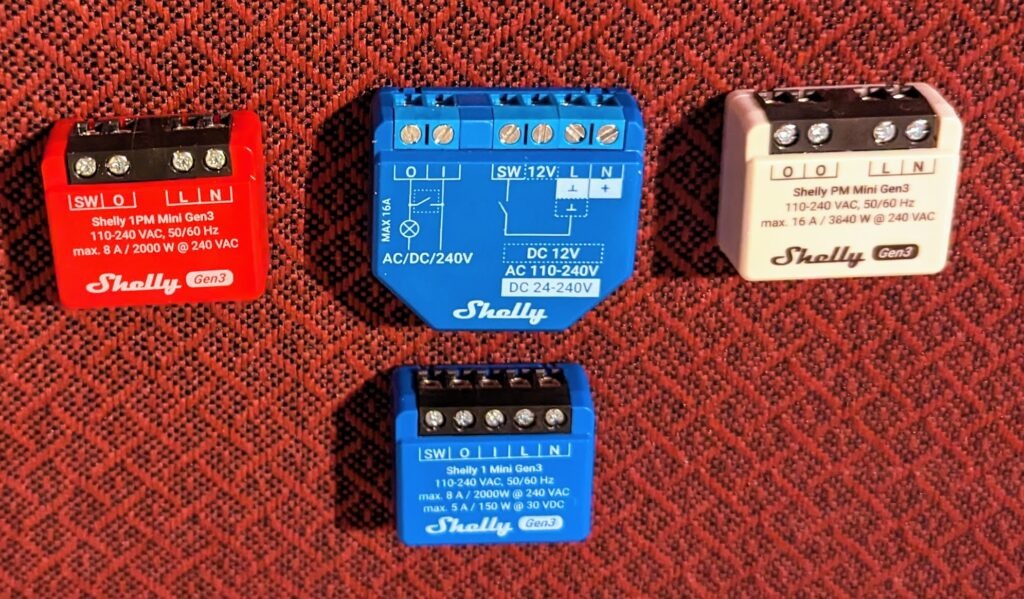
Shelly is my favorite smart home product producer. You can build an entire smart home using only Shelly products. My favorite Shelly products are their smart relays, including the Shelly 1 and the Shelly 1 Plus. I use them for all kinds of solutions, including garage door openers, smart switches, and automating my fireplace. Recently I got my hands on their newest lineup of similar products — the Shelly Mini Gen3 lineup. Let’s discuss what they are, what they can do, and how they compare to Shelly’s similar products.
This page contains affiliate links. If you purchase an item using an affiliate link I will receive a small commission at no cost to you. Affiliates do not influence my recommendations. Read my disclosures for more information.
Table of Contents
What are the Shelly Mini Gen3 devices?
Shelly Mini Gen3 device overview
All of Shelly’s smart relays, including these Gen3 devices, can open/close a relay and/or monitor power usage for any circuit they are connected to. They are all smart; meaning they can be controlled by an app, web interface, or integration with a smart home ecosystem like Alexa, Google Assistant, and even Home Assistant.
One of the features that sets shelly devices apart from other devices is that they offer local control. This is important because it allows you to control your device without relying on a third-party cloud system (and thus can work even when your Internet connection is down). It also allows control over the privacy of your smart home device usage data.
In addition to being able to connect to your Wi-Fi network, Shelly Mini Gen3 devices also feature Bluetooth control.
You can buy these and other Shelly products directly from Shelly via the links below:
Mini Gen3 Specifications
| Shelly 1 Mini | Shelly 1PM Mini | Shelly PM Mini | |
|---|---|---|---|
| Size | 1.11 x 1.35 x 0.63 in | 1.11 x 1.35 x 0.63 in | 1.11 x 1.34 x 0.63 in |
| Weight | .65 oz | .63 oz | .46 oz |
| Power Supply | 110 – 240 VAC | 110 – 240 VAC / 24 – 30 VDC | 110 – 240 VAC |
| Power Consumption | < 1.2 W | < 1.2 W | < 1.2 W |
| Relay | Dry contact/No Contact | No Contact | None |
| Max AC Switching Voltage | 240 V | 240 V | N/A |
| Max DC Switching Voltage | 30 V | N/A | N/A |
| Max AC Switching Current | 8 amps | 8 amps | N/A |
| Max DC Switching Current | 5 amps | N/A | N/A |
| Max AC Switching Power | 2000 W | 2000 W | N/A |
| Max DC Switching Power | 150 W | N/A | N/A |
| Wi-Fi protocol | 802.11 b/g/n | 802.11 b/g/n | 802.11 b/g/n |
| Bluetooth Protocol | 4.2 | 4.2 | 4.2 |
| Power Measurement | No | Yes | Yes, (up to 16 amps/ 3840 W) |
| Voltage/Current/Power Protection | No | Yes | No |
As you can see from the spec table above, the products are similar in size and function. However, they do have some key (highlighted) differences:
- The Shelly 1 Mini Gen3 has a dry contact, meaning the contact is isolated from the power source. This is useful when the power you want to switch on and off with the relay differs from the input power, like in my garage door or fireplace example.
- Speaking of contacts, the Shelly PM Mini Gen3 does not have a relay. This device is intended for measuring power and has a much higher current and power limit for what it can measure and handle as compared with the other two devices.
- The Shelly 1PM Mini is like a combination of the devices. It can measure power and has a relay, but it handles and measures less power than the PM Mini Gen3 and doesn’t have a dry contact like the 1 Mini Gen3. It can be powered by DC voltage, a feature unique amongst these devices.
How do they compare to the Shelly 1 Plus and Shelly 1PM Plus?

The first difference you notice from the naming and picture above is that the Mini Gen3 devices are smaller than the Plus devices. Specifically, they are 35% smaller, which can really help when installing them in small fixtures and gang boxes.
A difference that you can’t immediately see is in their processors and RAM. The Plus devices use an ESP32 processor with 4 MB of flash RAM, while the Mini Gen3 devices are upgraded to the Shelly ESP C38F processor with 8 MB of flash RAM.
As you can tell by the coloring and naming, the Shelly 1 Mini Gen3 is similar to the Shelly Plus 1, the Shelly 1PM Mini Gen3 is similar to the Shelly Plus 1PM. Here are their differences:
- Unlike the Shelly Plus 1, the Shelly 1 Mini Gen3 can’t use DC as its input power. It can only handle switching 8A/5A (AC/DC, respectively) whereas the Shelly Plus 1 can handle 16A/10A.
- Similarly, the Shelly 1PM Mini Gen3 can handle 8A/5A switching, while the Plus version can handle 16A/10A switching
Other than those differences, they are functionally equivalent, and the wiring is mostly the same as well.
The Shelly PM Mini Gen3 doesn’t have a Plus line relay comparison, as it uniquely only measures power and is not a switch/relay.
If you’d like to know more details about the Shelly Plus relays, be sure to read my overview of them and how they differ from the original Shelly relays.
Editor’s Note: Be sure to check out our article about many other useful DIY projects you can do with a Shelly relay.
Final thoughts
The Shelly 1 Mini Gen3, PM, and 1PM devices are a welcome addition to the Shelly lineup. They are especially useful in very small places. They have been as stable as their predecessors and I highly recommend them.






The smaller size and no jumper change for low voltage is great. Until there are UL listed units, I will not use the new devices for household wiring. The potential liability is too great if I violate the rules of my home owners insurance.